 |
Simultaneous independent image display technique on multiple 3D objects |
|
In recent years, systems have been developed that provide effects for efficiently expressing spatial information using projectors in Augmented Reality (AR) and Mixed Reality (MR). For example, projection mapping can realize various visual effects by projecting an image to a building or a human being, and adding image information different from the original target. However, the projection from the projector is spatially invariant and does not change even if the position of the object changes.
In this research, different image projections are simultaneously realized for a plurality of objects having complicated free shapes. In addition, by using epipolar constraint, we developed a method to realize complicated optimization with a large amount of calculation by dramatically reducing the variables required for calculation, thereby realizing expansion of the dynamic range of projected images. 
This system realizes simultaneous projection of different images on plural planes by superimposing projection light of two projectors. The pattern projected by each projector interferes at depth 1 and (a) of the target image is projected. And when the manikin moves from the depth 1 to the depth 2, the pattern is no longer (a), and when the mannequin reaches the depth 2 the projected image of the projector interferes again and (b) is projected. 
In the case of two projectors, since the interfering patterns are limited on the epipolar line, it is possible to formulate for each epipolar line and can be divided into multiple independent small problems. 
Publications
|
| Kawasaki Laboratory |